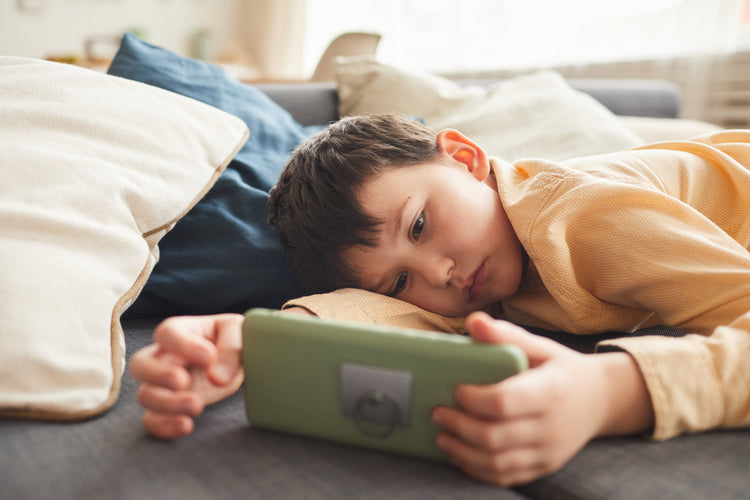Do weighted lap pads work?
While not for everyone, they may help! Weighted products, like lap pads, are used to provide deep touch pressure (DTP) (sometimes called Deep Pressure Stimulation). DTP is the “sensation produced when an individual is hugged, squeezed, stroked, or held” [1] It can help reduce symptoms of stress and help improve performance in school [2] [3]. In addition to weighted items some people use swaddling, holding, hugging, squeezing, stroking, and therapeutic brushing [4] for DTP therapy.
DTP can be incredibly helpful for children and adults who struggle with stress, inability to focus, sensory overstimulation, and other issues. It can be an essential strategy when it comes to regulating emotions and behavior.
Why choose a lap pad?
Unlike weighted blankets which are generally pretty large and intended for use while laying down or relaxing on the couch, weighted lap pads are excellent for use on the go, in school, the car, busy public settings, traveling, restaurants, etc. They’re easy to carry around and fairly discreet when compared to full blankets.
Lap pads, despite their name, don’t need to be used exclusively on the lap. They can also help when placed on the chest, back, or shoulders.
How long should a weighted lap pad be used?
They’re best used intermittently as the body and brain will adjust to the feeling of the weight over time. Experts generally recommend no more than 20 minutes at a time. But it doesn’t have to be 20 minutes, 5 minutes might be good enough for some. It’s up to each individual to determine how long is best for them.
Who benefits from DTP?
Deep Touch Pressure (DTP) has been shown to be helpful for children and adults with autism [2] [3], anxiety [1] [4], Attention Deficit/Hyperactivity Disorder (ADHD) [5], Sensory Processing Disorder, and those with intellectual disabilities [2].
How to be safe using weighted products
It’s important to be safe when using any weighted good. They are not safe for all ages and abilities and may cause harm or even death if used in an unsafe manner.
Weighted products should not be used by anyone (big or small) who does not have the muscle strength, coordination, or awareness to move it as it could become a suffocation risk. Infants and toddlers should not use weighted goods for this reason.
Weighted goods should only be used on people who have the strength, coordination, and awareness to use them safely and not put themselves at risk of injury.
How to use a weighted lap pad at school
Weighted lap pads can help kids at school during activities that require kids to remain seated and focused, whether it’s during class or even assemblies. Studies show that using weighted goods can be helpful in keeping kids with attention difficulties on-task [6]. They can help kids when they need to stay seated at their desk, sit for circle time, sit and do their homework, or while traveling on the bus to and from school. Depending on how and when it’ll be used, you may wish to ask that your weighted lap pad be left in the classroom with the teacher so your child doesn’t need to carry it to and from school.
What to consider when buying a weighted lap pad?
There are many options available on the market. Here are some things to consider:
Material – what is the fabric and texture of the item? Will it be calming / soothing to who is going to use it? Are there textures or features that will be distracting?
Construction – is the item durable? How does the weight stay in the item? Some use hook and loop closures, some use zippers, some are sewn shut. These things impact the feel of the item, the noises it makes, washability, and durability.
Weight Distribution – is the interior constructed in channels or boxes to ensure the weight remains evenly distributed during use? This is important because you don’t want all of the weight shifting around as you move the item.
Filler – what is the item weighted with? There are numerous options, each with pros and cons. But the biggest thing to consider is if the filler is washable (or if not, if the weight can be removed for washing).
Weight - Most weighted goods come in preset weights, sometimes what’s available is not the best weight for the end user. Consider our DIY lap pads if you’re not sure which weight is best, for growing kids, or if you want an uncommon weight.
Washability – Is washable? Wipeable? Waterproof? You’ll want to make sure you can clean the item properly, especially if the person using it is more prone to spills.
References:
-
Krauss K. E. The effects of deep pressure touch on anxiety. The American Journal of Occupational Therapy. 1987;41(6):366–373. doi: 10.5014/ajot.41.6.366.
-
Bestbier, L., & Williams, T. I. (2017). The Immediate Effects of Deep Pressure on Young People with Autism and Severe Intellectual Difficulties: Demonstrating Individual Differences. Occupational therapy international, 2017, 7534972. https://doi.org/10.1155/2017/7534972
-
Owen-Smith A. A., Bent S., Lynch F. L., et al. Prevalence and predictors of complementary and alternative medicine use in a large insured sample of children with Autism Spectrum Disorders. Research in Autism Spectrum Disorders. 2015;17:40–51. doi: 10.1016/j.rasd.2015.05.002.
-
Chen H.-Y., Yang H., Chi H.-J., Chen H.-M. Physiological effects of deep touch pressure on anxiety alleviation: the weighted blanket approach. Journal of Medical and Biological Engineering. 2013;33(5):463–470. doi: 10.5405/jmbe.1043.
-
Temple University Health Sciences Center. (2005, May 13). Study Finds ADHD Improves With Sensory Intervention. ScienceDaily. Retrieved November 10, 2022 from sciencedaily.com/releases/2005/05/050513103548.htm
-
VandenBerg N. L. (2001). The use of a weighted vest to increase on-task behavior in children with attention difficulties. The American journal of occupational therapy : official publication of the American Occupational Therapy Association, 55(6), 621–628. https://doi.org/10.5014/ajot.55.6.621




